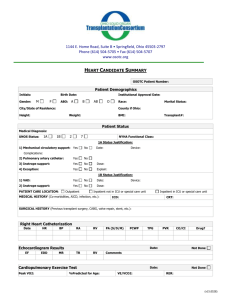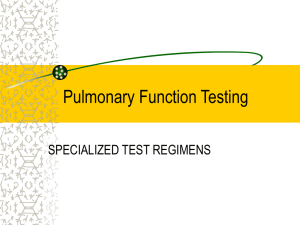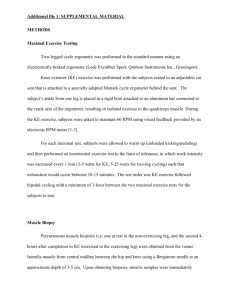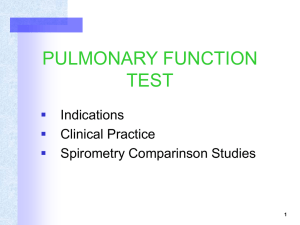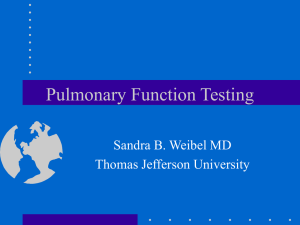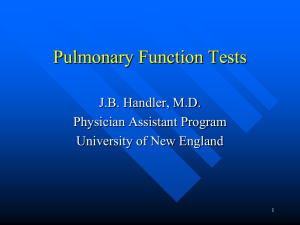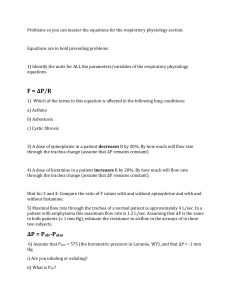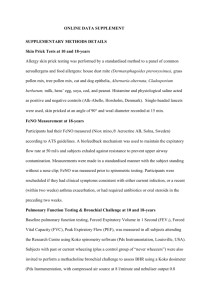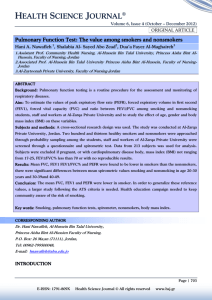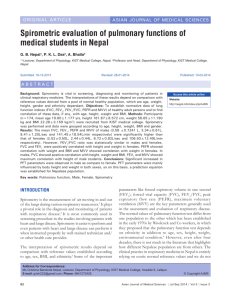Pulmonary Function Lab Activity (LR3)
advertisement
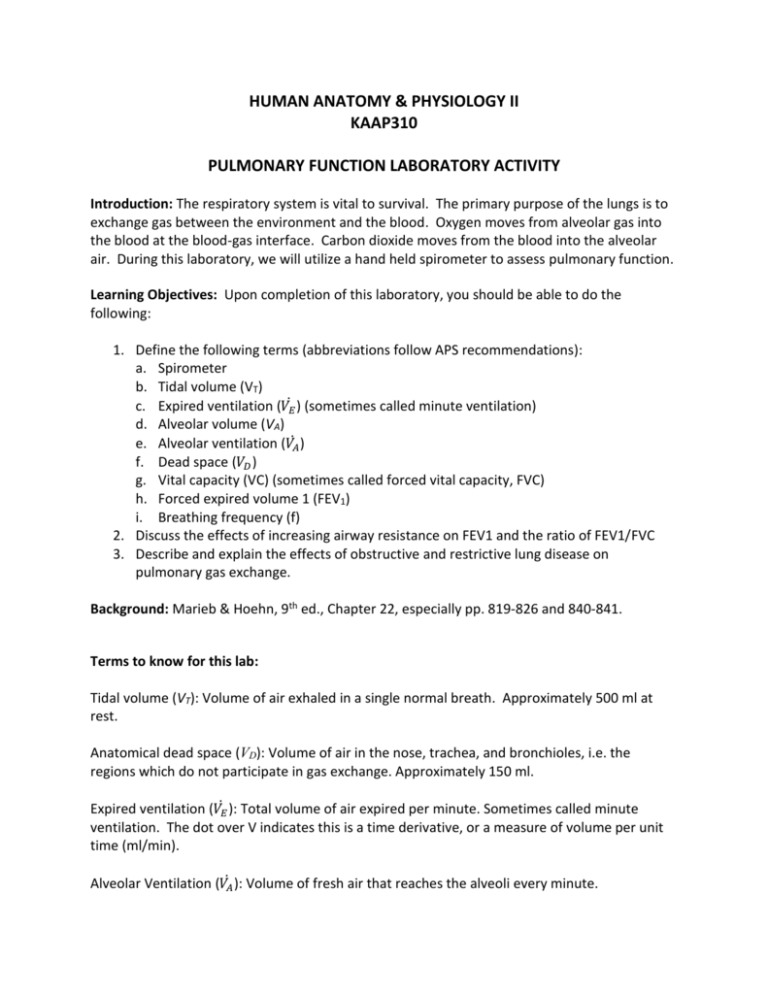
HUMAN ANATOMY & PHYSIOLOGY II KAAP310 PULMONARY FUNCTION LABORATORY ACTIVITY Introduction: The respiratory system is vital to survival. The primary purpose of the lungs is to exchange gas between the environment and the blood. Oxygen moves from alveolar gas into the blood at the blood-gas interface. Carbon dioxide moves from the blood into the alveolar air. During this laboratory, we will utilize a hand held spirometer to assess pulmonary function. Learning Objectives: Upon completion of this laboratory, you should be able to do the following: 1. Define the following terms (abbreviations follow APS recommendations): a. Spirometer b. Tidal volume (VT) c. Expired ventilation (𝑉𝐸̇ ) (sometimes called minute ventilation) d. Alveolar volume (VA) e. Alveolar ventilation (𝑉𝐴̇ ) f. Dead space (𝑉𝐷 ) g. Vital capacity (VC) (sometimes called forced vital capacity, FVC) h. Forced expired volume 1 (FEV1) i. Breathing frequency (f) 2. Discuss the effects of increasing airway resistance on FEV1 and the ratio of FEV1/FVC 3. Describe and explain the effects of obstructive and restrictive lung disease on pulmonary gas exchange. Background: Marieb & Hoehn, 9th ed., Chapter 22, especially pp. 819-826 and 840-841. Terms to know for this lab: Tidal volume (VT): Volume of air exhaled in a single normal breath. Approximately 500 ml at rest. Anatomical dead space (VD): Volume of air in the nose, trachea, and bronchioles, i.e. the regions which do not participate in gas exchange. Approximately 150 ml. Expired ventilation (𝑉𝐸̇ ): Total volume of air expired per minute. Sometimes called minute ventilation. The dot over V indicates this is a time derivative, or a measure of volume per unit time (ml/min). Alveolar Ventilation (𝑉𝐴̇ ): Volume of fresh air that reaches the alveoli every minute. Vital capacity (VC) (sometimes called Forced Vital Capacity, FVC): The maximal amount of air exhaled after a maximal inspiration. Approximately 4000-5000 ml. Normal values depend on gender, race, age, and size. Forced expired volume in one second (FEV1): The amount of air exhaled in the first second of a maximal exhalation. Normally 75-85% of VC. Breathing frequency (f): Number of breaths per minute. Know the following relationships Expired ventilation (minute volume) = volume of air exhaled per minute: 𝑉𝐸̇ = 𝑓 ∙ 𝑉𝑇 Alveolar ventilation rate = volume of fresh air reaching alveoli each minute: 𝑉𝐴̇ = 𝑓 ∙ (𝑉𝑇 − 𝑉𝐷 ) Experiment 1: Spirometry Techniques Measurement of pulmonary function by spirometry is common in clinical medicine. Spirometry involves measurement of the volume and rate of expired airflow. In general, the purpose of spirometry is to diagnose airway disorders. For example, a patient with chronic obstructive pulmonary disease (COPD) will have difficulty expiring gas from the lung at a high rate because of airway blockage due to disease. This will result in reduced peak airflow rates and a reduction in FEV1. Do this exercise with your lab group. When performing this exercise, the subject must wear a nose piece to prevent air from escaping through the nasal passages. The subject will make a maximal inspiration, then quickly place their mouth around the mouthpiece creating a tight seal, and then exhale the air AS QUICKLY and as FORCEFULLY AS POSSIBLE. This requires effort on the part of the subject and other members of the group should verbally encourage that person to blow out the air quickly and forcefully. This is done to ensure an accurate measure of lung capacity. Also, it is important to try and exhale as much air as possible in the first second and to exhale all of the air in the lungs. Each person should perform three trials. The act will measure FVC, FEV1, and peak flow. The student will then calculate his/her FEV1/FVC ratio. The FEV1/FVC ratio is an indicator of airway obstruction. The next page shows a typical spirometry tracing from a male subject illustrating the components of total lung capacity. Before beginning the lab, your lab instructor will demonstrate the proper technique for this measurement. Fig. 22.16a, Marieb & Hoehn 9th ed. DATA COLLECTION Perform 3 trials of the forced expiratory airflow maneuver using the spirometer. Table 1 Trial 1 Trial 2 Trial 3 FEV1 (L) FVC (L) FEV1/FVC Once you have your FVC and FEV1 data, go to the Spirometry Reference Value Calculator on the CDC website: http://www.cdc.gov/niosh/topics/spirometry/RefCalculator.html At the CDC Spirometry page: Select “Hankinson 1999” as your reference source. Enter your gender, race, age and height. Enter the highest numbers you recorded for FVC and FEV1. Click the Calculate button. Fill in the table below, using the numbers that were just calculated. Table 2 Predicted Percent of Predicted Lower Limit of Normal FVC (L) FEV1 (L) FEV1/FVC (%) Answer and turn in the following questions in the next lab: 1. What was your vital capacity (FVC) and FEV1? What were these values as a percent of the normal (predicted) value for your gender, race, age, and size? Were your values WNL? 2. What does it mean when the FEV1 is < 70% of normal? What type of pulmonary disorder would this suggest? 3. If you were conducting a pulmonary function test on a person with pulmonary fibrosis, would you expect the following to be normal, below normal or above normal? FVC? FEV1? Explain why. 4. What was your FEV1/ FVC ratio? Was it normal? 5. What is a normal minute ventilation (expired ventilation) at rest? How high can the minute ventilation become during exercise? 6. If a subject has a breathing frequency of 20 breaths/minute and a tidal volume of 1200 mL, what is the person’s minute volume? 7. Calculate the alveolar ventilation rate (𝑉𝐴̇ ) for a subject with a breathing frequency of 16 breaths per minute, a tidal volume of 450 ml, and a dead space volume of 160 ml.

